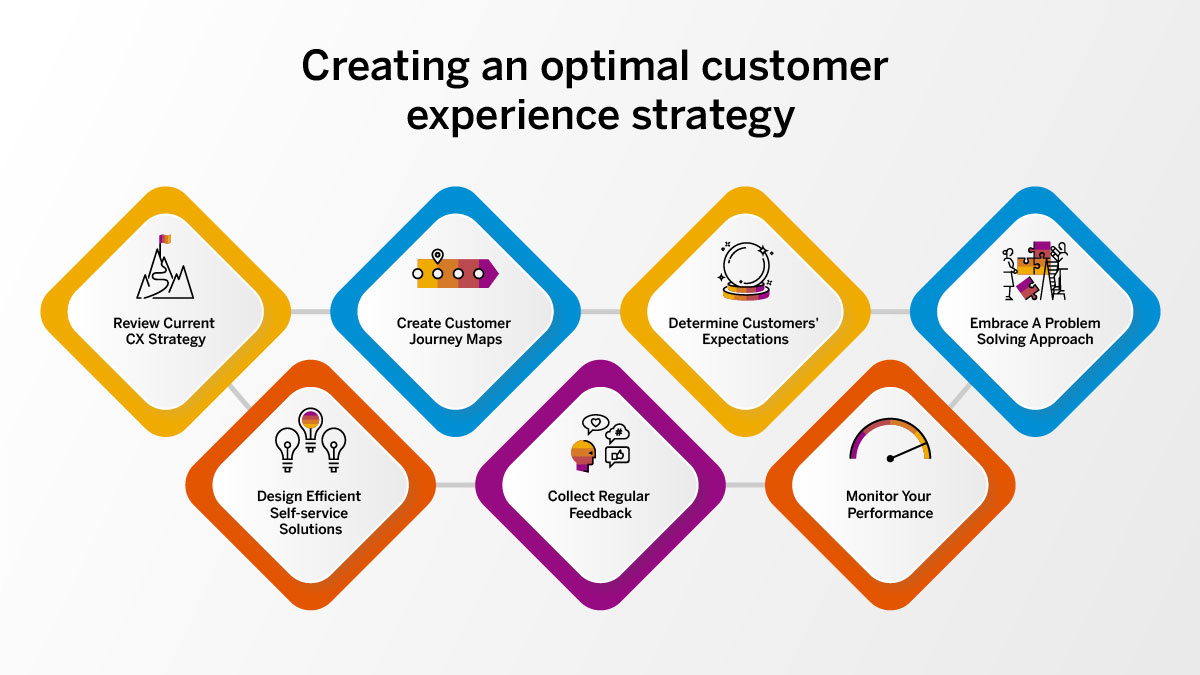Making sure the ‘customer is king’ is more important today than ever before. As customers get more choices, and are bombarded with information and service options, it has become even more difficult to woo and retain them. This makes it essential that businesses develop strategies that constantly aim to serve their customers better, personalize these services and elevate the customer experience.
And for businesses to be able to develop such strategies, they need to consider the customer experience (CX). There’s ample evidence that highly satisfied customers are loyal customers, who will not only come back to you but will also positively amplify your brand presence across digital platforms. So, creating the right CX strategy is an important factor that can determine the future of a business. Developing customer experience strategies has, in fact, become a top priority for marketing managers and researchers, surpassing even products and pricing. This is because studies have proven that:
- 73% of the customers consider customer experience as an important factor in purchasing decisions
- 65% of the customers believe a positive experience with a brand to be more impactful than great advertising
- 86% of buyers are willing to spend to have a great customer experience

This goes to show that customer loyalty is now subservient to good customer experience more than the price or even the product. Customer experience has even become the fundamental basis for marketing management and the key brand differentiator for a customer, overtaking the product and other factors like advertising. If your business can provide the customer with a good experience through the service, you can expect them to spend more and stay loyal to your brand for longer. Better CX strategies can also enable your business to grow more customers. Nearly 71 percent of customers end a business relationship due to a poor customer service experience.
A good CX strategy can therefore bring in big profits and help avoid losses through customer defection. Whether big or small, businesses can look at greater profits and greater customer loyalty by adopting successful CX strategies. By implementing robust and unified processes, the customer experience can be improved, thus bringing additional business value with innovation, flexibility, elasticity, and simplification.
But developing a good CX strategy may be a little trickier than it seems. This is because different businesses have differing ideas about what customer experience entails. While some relate it to the services and offerings that businesses stage and manage, others associate it with the customer responses to the contacts made and interactions conducted at the businesses. This diverse conceptualization of what constitutes a good CX strategy makes developing these strategies difficult.
A good customer experience strategy promotes a frictionless experience for the customer anytime and anywhere – whether they are accessing a service offered by your business or interacting with an employee of your organization. CX strategy is centered on improving products and processes to meet customers’ expectations. To fulfill all these aspirations and create an optimal customer experience strategy, it is therefore essential to consider doing the following:

- Review Current CX Strategy
Every process for creating something new starts from reviewing the previous versions. This helps in retaining the positives and removing the shortcomings. So, the first step towards creating a good CX strategy for your business is reviewing your company’s current approach towards customer service. A review of your current CX strategy helps you determine what is working well for your business and what is not. The review process may include steps like:
- Checking the data from your company’s feedback departments like call center data for key metrics. These may include parameters such as Net Promoter Score (NPS), Customer Satisfaction (CSAT) score, and customer churn rate.
- Consulting experts and asking them for recommendations. Expert recommendation services such as the one integrated within SAP’s CX Works provide insights into what is working right and what is not. They also provide strategic guidance to maximize value and keep your strategies relevant. The knowledge from the field experts not only helps your business to draw a roadmap for further course of action, but also for driving adoption of suggested measures and solutions. Expert recommendations can also be used for deploying, integrating, and using these solutions.
- Formulating and adopting project framework solutions. The project frameworks describe the approach, phases, and deliverables for the implementation of each solution. The frameworks also provide you with the guidance to optimize the time-to-value for your projects, with the mindset of start fast, stay fast.
All these can help you determine the best course of action for improving customer experience.
- Creating Customer Journey Maps
A customer journey map outlines the interactions and experiences between your customer and your business. This data helps to understand and analyze how the customer can be better serviced by reducing the friction within your customer experience and enhancing the satisfaction of the customer.
A customer journey map may be created through various pathways. These include gathering perceived and self-reported users’ responses. However, a more efficient customer journey map can be created through a dual approach. The dual approach involves gathering explicit and implicit data for understanding the dynamics between your customer and your business.
Explicit data may include self-reported information from within the business. In contrast, implicit data might include automatic and unconscious bio-physiological reactions obtained from tools such as sensors and IoT-based tech. This dual approach helps to understand better how the customer reacted unconsciously and automatically from an emotional and cognitive standpoint throughout their journey with your business.
A well-crafted customer journey map generates valuable information that can be used by different departments within a business. For example, the design and development department may design the product according to customer reactions. And the marketing and communication departments may use this data to create more effective marketing campaigns.
- Determining Customers’ Expectations
Customer satisfaction is based on exceeding customer expectations, while customer delight means positively surprising customers beyond their expectations. It has been found that both customer satisfaction and customer delight are vital to deliver a satisfying and memorable customer experience. This becomes crucial to retain a customer and make the customer spread a positive word of mouth.
Therefore, to understand customer expectations better, it is crucial to know to whom exactly you are selling a service or a product. By defining your customer and understanding their demographic, behavioral and psychographic attributes, you can personalize your products and services to best suit their needs.
Customer expectations can also be determined through a better understanding of customer experience with your business. Customer experience can be defined as a consumer’s internal and subjective response to any direct or indirect contact with your business. This response may be:
- Cognitive- An experience with your business may create an impression of your brand in the customers’ minds.
- Emotional- The experience may induce an emotion in the customer. For example, a satisfactory experience derived from gratifying service may remind the customer of a good memory. It has been well-documented that customers establishing an emotional connection with a point of contact of a brand, such as a customer service agent, willingly continue to do business with the company. These emotional connections are especially important in a good CX strategy.
- Behavioral- The experience with your business may induce a particular behavior in the customer. For example, efficient service may persuade the customer to buy more than what they intended in the first place.
- Social- These include the responses stimulated because of how the customer perceives the reactions of other customers towards your brand. If the others are happy, the chances are that a specific customer may perceive your services to be gratifying upon noticing other customers.
Positive responses are triggered by positive characteristics of the product or brand or other elements, such as a company’s website or mobile application. This response, or a combination of them, can be intentionally triggered by the brand. The reactions may also be stimulated by other factors which may not necessarily be under the company’s control, for example, by online customer reviews, blogs and virtual communities. Keeping all these aspects in mind while creating a CX strategy can help manage customers’ expectations and ultimately lead to a fulfilling and engaging customer experience.
- A Problem-Solving approach
Anticipating problems might be one of the most crucial benefits of a holistic customer strategy. An effective customer service strategy focuses on minimizing the hassle and remedying the problems for the customers. This approach also involves gathering both explicit and implicit data. This helps take remedial measures as soon as a problem or an error is detected and help prevent inconvenience to a customer. Risk reduction in the areas of project preparation and governance, design, solution, and readiness ensure that the customer feels safe and secure while interacting with your business as well as during transactions with your business.
Customer success teams are also an efficient way to prepare for problems and errors. A customer success team plans for worst-case scenarios, develops procedures for problems and continuously monitors the responses to issues arising. All these make it easy to plan and prevent problems. This type of proactive customer service reduces customer churn and increases customer loyalty and trust.
- Self-Service Solutions
To maximize loyalty, a trustworthy customer experience requires carefully managing detailed information about individual customers and all customer touchpoints. A unified user experience across all touchpoints, therefore, requires cross-team collaboration and data flow planning.
One of the most important points to consider is allowing the customers to find solutions on their own with minimal intervention from your business. This entails the use of a broad range of technologies to support your company’s customer relationship approach. It also requires aligning product experts and including the client project team in planning discussions. Another critical factor in designing efficient self-service solutions involves understanding customer behavior and needs.
All these factors help to create an environment of trust between your customer service team. It also ensures a deeper understanding of the architecture of your services, resulting in the creation of an omnichannel service. With the help of these channels, your business can offer self-service support options like chatbots, leading to a saving up on resources and a better customer service experience.
- Feedback
With greater interaction of businesses with customers, the customers have also become more vocal about their experiences with a business. This has led to the generation of massive amounts of customer feedback. This feedback, which includes both structured and unstructured data, can be highly beneficial for your business. Structured feedback is the one that is sought from the customer, for example, in a survey. While as unstructured feedback includes information such as customer suggestions, customer complaints and customer feedback left on social media sites.
Regular collection of feedback helps in multiple ways:
- It helps to minimize the risk of developing unsuitable and irrelevant products
- Information on customer needs gathered from feedback helps to direct research and development (R&D) to launch new products and services
- Customers’ suggestions and complaints help generate ideas to determine product concepts
- Feedback gives your business an insight into customer expectations and the level of their satisfaction with your product or services
- Monitoring your performance
Just like businesses and the technologies they use, the customer preferences keep changing consistently. Customers, just like businesses, are on the lookout for the best returns on their investments. This constant change in customer preference and behavior should be reflected in your business as well if you are to deliver a satisfactory customer experience. Adaptation to customer needs and demands in providing the service is therefore essential. This requires maintaining a synergy between different departments of your business. Tools such as Integrations can be required for maintaining consistent data flow across multiple systems. They help keep your business operations smooth, as well as ensure that none of the departments are lagging in terms of performance.
There’s no doubt that businesses need to deal with many operational challenges, especially when unforeseen disruptions change how business is done. But keeping a laser focus on customer experience that is delivered through high-quality customer service can make all the difference. Businesses need to respond with empathy and agility, given the ever-changing customer needs in today’s world. And all these shifts make it essential to develop effective CX strategies that can help deliver greater customer delight.



